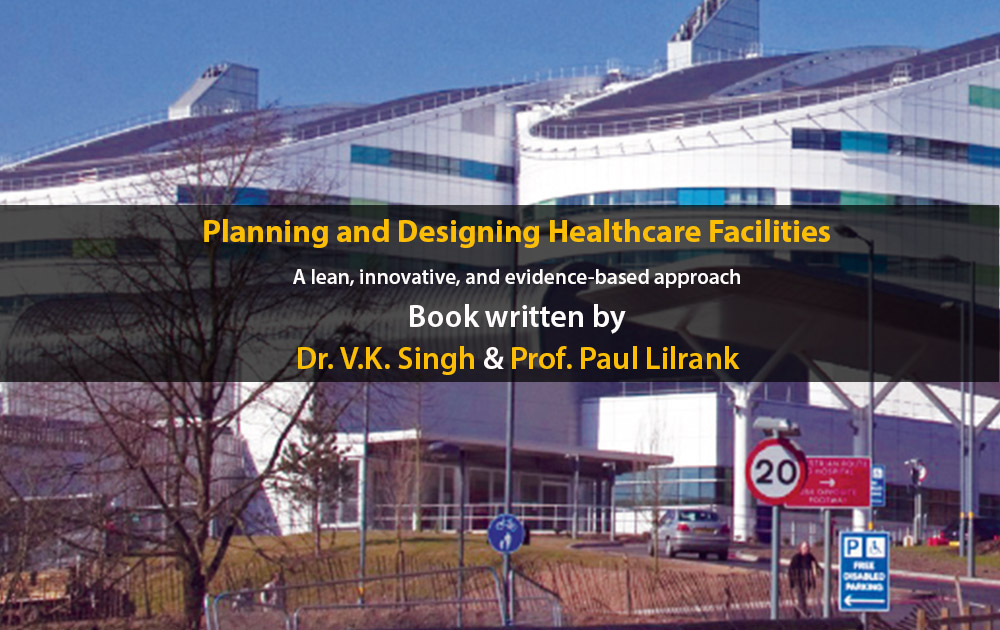Hitting newsstands in the United States of America and India simultaneously, A New Book–Planning and Designing Healthcare Facilities: A Lean, Innovative and Evidence based approach by Dr V.K. Singh and Prof. Paul Lillrank call for a fresh approach in designing new age hospitals in the wake of emerging new normal in the healthcare sector.
Authors say modern medicine is founded on the scientific pursuit for knowledge about the human body and its pathologies. Science builds theories and tests them against evidence. The scientific method should now be applied to the design of hospitals and health service systems. This is the rationale for evidence – based design.
According to authors, lean and innovation complement each other. Lean means creating more value for customers with fewer resources. Innovation is a process of translating an idea into goods or services that create value for which customer is ready to pay. The General Hospital is still a valid concept and is not going to disappear anytime soon, particularly in parts of the world where public health is poor, resources are scarce, and a majority of people is underserved. While visions are always welcome, the task at hand, and the theme of this book, is to improve on the Dominant Design, the standard General Hospital.
Evidence-based design (EBD) emphasizes credible evidence to influence design. It works on well-defined problems, applies a multidisciplinary perspective, involves users and customers, establishes quantitative performance measures for critical variables, and uses tests and simulations throughout the design process.
Prof. Lillrank along with Riikka-Leena Leskelä and Olli Tolkki say the hospital has traditionally been seen as a production site like a factory where flows of material, people, energy and information combine with fixed assets. In modern manufacturing, the factory has evolved into supply networks. In a similar vein, the modern hospital is seen as a node in a regional service system. A hospital design initiative should therefore begin with a master plan that defines the hospital’s place and role in a broader health service system.
Dr. Singh in a chapter on ‘Patient First, Functions Next and Design Later’ along with Mr. S K Biswas says the evolution of hospital design principles has gone through stages.
The first was ‘functions follow design’, as services had to be adapted to whatever structures were available. Next came ‘design follows functions’. Various professional groups lined out their requirements in terms of floor space and layout. More recently, the concept ‘Design follows first patients, then functions’ has been adopted. The emphasis now is on integrating the needs of patients, hospital functions, and functionaries in hospital design.
In a chapter, ‘Green Hospitals and Sustainable solution to Healthcare Facility’, Mr. Rajeev Boudhankar says as important parts of the modern urban landscape, hospitals must adopt environmentally friendly and sustainable designs and technologies. Green hospitals use energy, water, materials and land more efficiently than conventional buildings.
With more natural light and better air quality, green buildings contribute to improved health, comfort, and productivity. The LEED 2009 for Healthcare Green Building Rating System is a set of performance standards for certifying healthcare facilities.
In ‘Designing a Patient-centric Healthcare Facility Using Lean Methodology’, Mr. John Gallagher, Kim Chaney and Ron Kwon say 2P (Process Preparation) is a Lean design tool that helps to organize the flow of activity in a way that results in the least amount of waste. This chapter details how it worked when Concord Hillside Medical Associates, a multi-specialty group practice part of Harvard Vanguard Medical Associates near Boston, applied it in a major facility design project.
Likewise, in an article on ‘Creating safer healthcare environments using an evidence-based design process, Dr. Anjali Joseph, Ellen Taylor and Xiaobo Quan say a growing body of research shows that the healthcare built environment impacts safety outcomes such as infections, medication errors, falls, and staff injuries. Latent conditions that adversely impact patient safety are built into the physical environment during the planning, design, and construction phases. Design decisions should be proactively evaluated by engaging users from different disciplines such as infection control, nursing, risk managers, and environmental services. Emerging tools such as the Safety Risk Assessment (SRA) toolkit provide a structured way to apply evidence-based design to improve patient safety.
Dr. Singh and Dr. Biswas in another chapter on ‘Evidence Based Design in Hospitals – Theory to Implementation’ opine that the principles of Lean Healthcare support Evidence Based Design. Lean calls for the identification of all major stakeholders and specifying what they consider valuable. Stakeholder value can be grouped into the basic categories tangibility, reliability, responsiveness, assurance and empathy. When these requirements are not met, processes create waste.
EBD analyze the constraints that need to be addressed. The design process covers several stages, initial hypothetical design, process design, service design, and empirical design. These principles are detailed in a case in a hospital in Kolkata.
On Virtual Hospitals of Future, IT expert Sachin Gaur says the Information and Communication Technologies (ICT), particularly smart and wearable devices, have the potential to break constraints of time and location. Physical installations may turn virtual, and centralized services may be decentralized. Assessing the potential of new technologies, the CIMO -methodology of Evaluation Science can be employed. It asks the questions, what is the context in which technology is applied through what kinds of interventions, and which mechanisms are activated to produce which outcomes?
On ‘Redefining Healthcare of Tomorrow in Smart City’, Dr Singh and Ms. Nimisha Singh say the three pillars of the smart city are-people, process, technology, and the information flows that bind them together as an optimized whole. The Smart Cities Mission under the leadership of Prime Minister Narendra Modi is an initiative towards urbanization. Smart cities require smart healthcare.
With the Internet of things (IoT), layers of smartness are being added to the hospitals, such as remote monitoring, chronic disease management, medication management, patient self-management, and workflow management.
In a Chapter titled ‘Delivering Inclusive Intelligent Healthcare’ by Innovative and Comprehensive e-Health System, Dr. Kuo Shou-Jen and Lai Chien-Wen aver that the chapter is based on a case study of Changhua Christian Healthcare System (CCH), Taiwan. CCH has been a pioneer in implementing sophisticated new technologies. The case emphasizes the importance of the combination of high tech with human touch.
In a chapter on ‘Planning Safe Hospitals’, Ms. Sushma Guleria says that the Hyogo Framework for Action 2005-2015 (HFA) spells out the challenge to substantially reduce the impact of disasters and to make risk reduction an essential component of development policies and programs. Risk reduction planning should be integrated into the health sector to make hospitals safe from disasters and strengthen their capacity to remain functional in disaster situations. Hospitals need to have disaster management plans and to evaluate their performance by implementing the Hospital Safety Index used widely to gather information for sound decision making.
In an article on ‘Designing Innovative Facilities: Contamination & Security Hazards at Hospitals’, Dr. Singh along with Dr. Raman Chawala emphasis on the danger of chemical, biological, radiological, nuclear and explosive (CBRNE) related terrorism which pose a contamination threat to healthcare institutions. Designing innovative resilience can provide long term and effective solutions by establishing a rigorous framework that can accelerate adaptation and ability to recover from any known and unknown contamination security and safety hazards.
‘Adapt or Obsolesce: The evolution of the Singapore Health System’, Matthew Saunders said Singapore is an advanced country of small size with a single party dominated political system. This has made it agile and able to respond quickly to changing circumstance in ways that differ from larger and more complex polities. Singapore faces the same challenges as other developing countries, including ageing society, non-communicable diseases and healthcare cost inflation, while it is well positioned to implement advanced technologies, such as electronic patient records and smart solutions. Singapore highlights the systemic nature of healthcare, where service production, facility design, finance, and regulation require innovative approaches to integration.
Dr. B. R. Shetty, Founder and Chairman, NMC Healthcare, Abu Dhabi, United Arab Emirates in his foreword said, “The book is a timely effort to discuss various concepts and tools to reduce delivery costs and maintain high quality by the means of planning a hospital with an eye on operations. It details experiences from around the globe. The authors strive to integrate several strains of thought: Lean, Innovation, Patient Centricity, and Evidence–based designs. This is what the healthcare industry needs.
Want to write for InnoHEALTH? send us your article at magazine@innovatiocuris.com
Read all the issues of InnoHEALTH magazine:
InnoHEALTH Volume 1 Issue 1 (July to September 2016) – https://goo.gl/iWAwN2
InnoHEALTH Volume 1 Issue 2 (October to December 2016) – https://goo.gl/4GGMJz
InnoHEALTH Volume 2 Issue 1 (January to March 2017) – https://goo.gl/DEyKnw
InnoHEALTH Volume 2 Issue 2 (April to June 2017) – https://goo.gl/Nv3eev
InnoHEALTH Volume 2 Issue 3 (July to September 2017) – https://goo.gl/MCVjd6
InnoHEALTH Volume 2 Issue 4 (October to December 2017) – http://amzn.to/2B2UMLw
InnoHEALTH Volume 3 Issue 1 (January to March 2018) – https://goo.gl/fksdQx
InnoHEALTH Volume 3 Issue 2 (April to June 2018) – https://goo.gl/grbtRo
Connect with InnovatioCuris on:
Facebook: https://www.facebook.com/innovatiocuris
Twitter: https://twitter.com/innovatiocuris
LinkedIn: https://www.linkedin.com/groups/7043791
Stay updated about IC, visit: www.innovatiocuris.com



